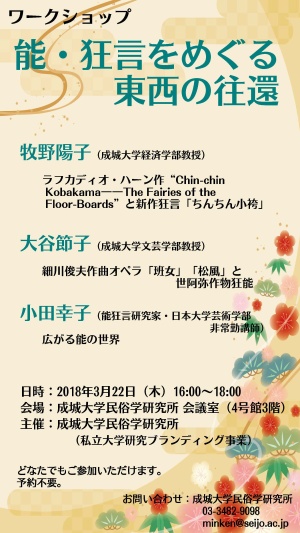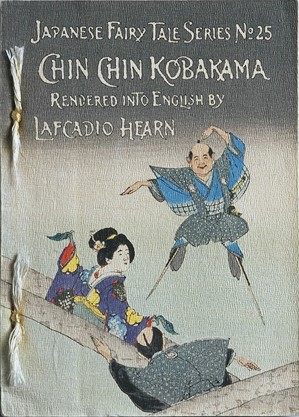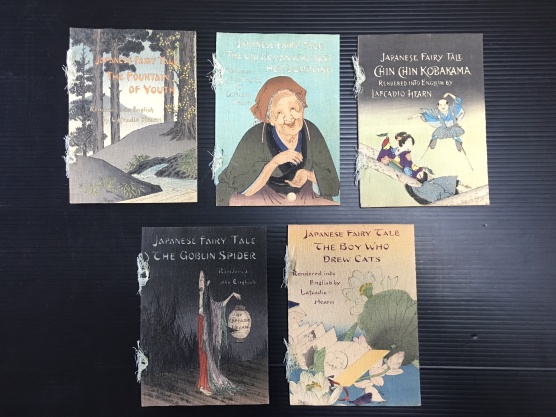

NEWS
2018.03.29
<Synopsis>
On Thursday, March 22, 2018, 16:00–18:00, a workshop titled “East-West Encounters in Noh and Kyogen” was held at the lecture hall of Seijo University’s Institute of Folklore Studies. The workshop formed part of the university’s project to “establish and promote a world-leading glocal-studies center that contributes toward a sustainable and inclusive society” (a MEXT-supported Research Branding Program for Private Universities). The program was as follows:

Yoko Makino (Faculty of Economics, Seijo University) “Patrick Lafcadio Hearn’s English Translation of Chin-Chin Kobakama: The Fairies of the Floor-Boards, and New Kyogen Productions of Chin-Chin Kobakama” Setsuko Otani (Faculty of Arts and Literature, Seijo University) “Toshio Hosokawa’s Operas, Hanjo and Matsukaze, and Zeami Motokiyo’s Mono-gurui Noh Plays” Sachiko Oda (Noh researcher and part-time instructor at the College of Art, Nihon University) “The Expanding World of Noh” General discussion
<Report>
July 2017 marked the 60th anniversary of diplomatic relations between Japan and the Republic of Ireland. To commemorate the occasion, the Republic’s three biggest cities hosted Kyogen productions by the Sengoro Shigeyama School. These productions were based on non-traditional Kyogen scripts. One was The Cat and the Moon, a work of William Butler Yeats (1865–1939). The other was Chin-Chin Kobakama: The Fairies of the Floor-Boards, an English version of a traditional Japanese fairytale, composed by Patrick Lafcadio Hearn (1850–1904; also known by the Japanese name Koizumi Yakumo).
Inspired by Noh Theatre, Yeats penned the English-language play, At the Hawk’s Well. Mirio Yokomichi composed a Noh script (under the title Taka no Ido) based on Yeats’ play, and it was performed on stage in 1949 by Minoru Kita. In 1967, the Tessen-kai Theatre Company revived the play in their production titled Taka Hime, or “Hawk Princess,” which was directed by Mannojo Nomura. Since then, the play has been performed numerous times, becoming the most staged non-traditional Noh play. In November 2017, two non-traditional Kyogen plays, based respectively on the above works of Yeats and Lafcadio Hearn, made their Japanese debuts in Matsue, a place that was dear to Lafcadio Hearn. In March 2018, the plays were performed again, this time at the National Noh Theatre in Tokyo.
In February 2018, the Toshio Hosokawa opera, Matsukaze, was performed at the New National Theatre; the production was scripted by Hannah Dübgen and choreographed by Sasha Waltz. Matsukaze was first performed at la Monnaie (Brussels, Belgium) in May 2011. The opera was then performed to great acclaim in venues across Europe, including the Grand Theatre (Warsaw, Poland), the Grand Théâtre de Luxembourg, the Berlin State Opera, and the Opera de Lille (France), before making its Japanese debut. Although the opera does not feature traditional Noh Theatre forms, such as Noh instrumentation, voice projection, costumes, and masks, it is based on the eponymous Noh play and it was strongly influenced by Noh.
The purpose of this workshop was to examine, from a glocal-studies perspective, how the two productions described above illustrate East-West encounters in Noh and Kyogen, from the end of the Edo period (when Noh and Kyogen were first introduced into Europe) until today.
Yoko Makino introduced her research on Patrick Lafcadio Hearn and discussed the Japanese Fairy Tale Series, a “chirimen-bon” (crêpe-paper book) series of Japanese folktales that the Irishman had translated. She also discussed the worldviews that are present in the original stories and the non-traditional Kyogen plays based on them.
In the next presentation, Setsuko Otani introduced her research on Noh Theatre and discussed how Matsukaze visually dramatized a Noh trope called “mono-gurui Noh” (Noh plays featuring a madman character). Drawing from her body of research into theatre, Sachiko Oda focused on musical aspects and discussed how Noh has influenced recent trends in music and theatre. With permission from the Tessen-kai Theatre Company, part of a video of a Taka Hime production was screened.

Front page of Chin-Chin Kobakama, part of the “chirimen-bon” Japanese Fairy Tale Series
Owner: Yoko Makino (Faculty of Economics, Seijo University)

Patrick Lafcadio Hearn’s “chirimen-bon” Fairy Tale Series
Owner: Yoko Makino (Faculty of Economics, Seijo University)